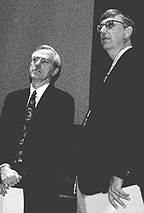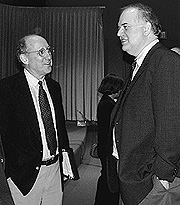IN A BLAESE OF GLORY
 |
|
Michael
Blaese: Profiled
|
Michael Blaese came to NIH in 1966 as a clinical associate at NCI, where he worked in the lab of Tom Waldmann, now chief of NCI’s Metabolism Branch.
By the time he moved over to NHGRI in 1994 to lead the clinical gene therapy program, Blaese had pioneered the first gene therapy treatment trial in the country. He and his colleagues French Anderson (then at NHLBI and now at the USC School of Medicine in Los Angeles, where he directs the Gene Therapy Laboratories) and Ken Culver (then at NICHD and now pharmacogenetics head at Novartis in East Hanover, New Jersey) used a retroviral vector to deliver corrective genes to patients born with adenosine deaminase immune deficiency. The historic moment that Blaese’s gene therapy protocol was approved by the NIH Recombinant DNA Advisory Committee (RAC) in 1990 was shared by NCI surgery chief Steve Rosenberg, whose own protocol to deliver IL-2 genes into tumor infiltrating lymphocytes in the treatment of melanoma also won approval at that RAC session.
Last year, Blaese made known his plans to leave NIH and on April 15 a gene therapy seminar was held here to honor him and wish him well in his new position as chief scientific officer and president of the molecular pharmaceuticals division of Kimeragen, Inc., of Newtown, Pennsylvania.
THE PAST IS PROLOGUE
 |
Recalling his early assignment as NHGRI director to establish an intramural research program in genomics and genetics, Francis Collins (right) recounted how he "wandered the corridors of Building 10, got lost, stumbled into an office the size of a closet, and there found Mike—a scientist with an international reputation with the obvious modesty not to ask for more space." In Mike Blaese, he said, was the "marriage of a sharp mind and a gentle spirit." Former gene therapy collaborator French Anderson (left) described continuing research that may lead to protocols for in utero gene therapy in the future. The approach, he said, is in vivo retroviral-mediated gene transfer into autologous blood cells at 17–20 weeks. Timing early in the second trimester moves beyond the first-trimester risk of germline involvement and also seizes the time when stem cells are most actively dividing and amenable to gene transfer, he noted.
 |
Said
Steve Rosenberg
(left) of colleague Mike Blaese:
"Mike has no concern about credit . . . .
there is a solidness to him."
 |
Generations: As Tom Waldmann (left), his first NIH mentor, put it, Mike Blaese (right) has provided "definitive answers for questions that couldn’t even be askedthree decades ago." Giovanna Tosato (bottom), a former student of Blaese, now director of hematologic products at the FDA’s Center for Biologics Evaluation and Research, credited Blaese with sharpening her research focus.